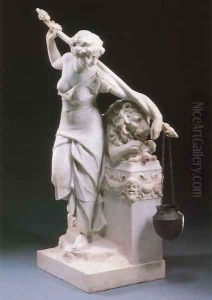Vincenzo Cerri Paintings
Vincenzo Cerri was an Italian painter and architect who was born in 1749 in Como, Italy. He was active during the late 18th century and the early 19th century, a period that saw significant transformations in art and culture as the neoclassical movement began to take hold, reflecting a renewed interest in classical antiquity.
Cerri was not as widely known as some of his contemporaries, and his work was primarily recognized in the regional context of Lombardy. Despite the limited geographical scope of his influence, Cerri contributed to the architectural and artistic landscape of his time. He was known for his work in sacred architecture, having designed several churches and religious structures in his native region. His designs are characterized by the neoclassical style, which was dominant at the time, emphasizing symmetry, clear structure, and references to classical forms.
Besides architecture, Cerri was also involved in painting, though his work in this field is less documented and studied. Paintings of the period often reflected the neoclassical aesthetic, with a focus on harmony, proportion, and the incorporation of themes from ancient Greece and Rome.
Cerri's career spanned a tumultuous period in European history, including the French Revolution and the Napoleonic Wars. These events inevitably influenced the cultural and artistic environment in which he worked. As an artist and architect, Cerri would have had to navigate the shifting political and cultural landscapes of his time.
Vincenzo Cerri passed away in 1821 in his hometown of Como. While he may not have achieved the same level of fame as some of his peers, his work remains a testament to the neoclassical movement in northern Italy and provides valuable insight into the local manifestations of a broader European artistic trend. Unfortunately, due to the lack of extensive records and scholarly attention, much of Cerri's life and work remain obscure, and details about his personal life and career are relatively scant.
